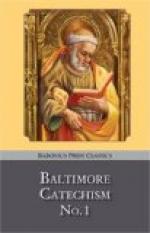Just as in the Lord’s Prayer we do not see all its meaning at first, so in the Apostles’ Creed we find many beautiful things only after thinking carefully over every word it contains.
“I believe,” without the slightest doubt or suspicion that I might be wrong.
“In God” by the grace that He gives me to believe and have full confidence in Him.
“God,” to show that there is only one.
“The Father,” because He brought everything into existence and keeps it so (see Explanation of the Lord’s Prayer).
“Almighty,” i.e., having all might or power; because He can do whatever He wishes. He can make or destroy by merely wishing.
“Creator.” To create means to make out of nothing. God alone can create. When a carpenter makes a table, he must have wood; when a tailor makes a coat, he must have cloth. They are only makers and not creators. God needs no material or tools. When we make anything, we make it part by part; but God makes the whole at once. He simply wills and it is made. Thus He said in the beginning of the world: “Let there be light; and light was made.” For example, suppose I wanted a piano. If I could say, “Let there be a piano” and it immediately sprang up without any other effort on my part, although neither the wood, the iron, the wire, the ivory, nor anything else in it ever existed till I said, “Let there be a piano,” then it could be said I created a piano. No one could do this, for God alone has such power.
“Heaven and earth” and everything we can see or know of.
“Jesus Christ.” Our Lord is called by many names, but you must not be confused by them, for they all mean the same person, and are given only to remind us of some particular thing connected with Our Lord. He is called “Jesus,” which signifies Saviour, and “Christ,” which means anointed. He is called the “Second Person of the Blessed Trinity,” and when we call Him “Our Lord,” we mean the Second Person of the Blessed Trinity after He became man. He is called the “Messias” and the “Son of David” to show that He is the Redeemer promised to the Jews. Also at the end of all our litanies He is called the “Lamb of God,” because He was so meek and humble and suffered death so patiently. In the Litany of the Holy Name of Jesus we will find many other beautiful names of Our Lord, all having their special signification.
“His only Son,” to show that God, the First Person of the Blessed Trinity, was His real Father. We are called God’s children, but we are only His created and adopted children.
“Who was conceived,” i.e., He began to exist by the power of the Holy Ghost in the womb of His Mother, the Blessed Virgin.
“Suffered.” We shall see in the explanation of the Passion what He suffered.
“Under” means here, at the time a man named Pontius Pilate was governor. If anyone were put to death today in this country, we should say he was executed under Governor or President so-and-so. “Crucified,” i.e., nailed to a cross. We say “died,” because Our Lord is the Giver of Life, and no one could take His life away unless He allowed it. Therefore we say He died, and not that He was killed, to show that He died by His own free will and not against His will.




